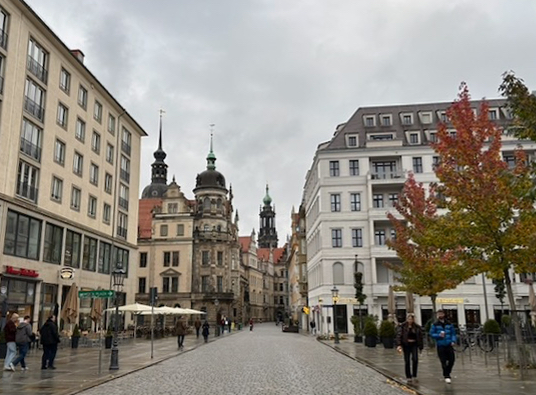
Schloßstraße, Dresden
Earlier in June, I waxed lyrical about Dresden in southeast Germany which was the scene for several chapters in my latest thriller Double Stakes. Never having been there, I had written heroine Mel and hero Jeff’s scenes using Google Maps.
What a shocking admission!
Moving a character through a place needs a lot of research and it’s a good thing I’m a map enthusiast (read: obsessive). So it worked. I suppose that at this stage I should also admit I did the same for INCEPTIO and New York City. But I did visit NYC afterwards and was delighted when I discovered that Mr Google Maps had not let me down.
However, for Double Stakes I carried out a fair amount of other research not only about the local geography, history, industry, German politics and train times, but also weather, language and food. I’d studied German in my university days and been a student there, albeit in West Germany as it was then. East Germany was not really a place you visited at that time.

After publishing Double Stakes, I thought it would be nice to actually see Dresden one day. Being in your setting and doing the ‘soaking up the atmosphere’ thing cannot be beaten. However, that was a nebulous hope wafting around in an indeterminate future.
Then Fortuna intervened. Well, it was really writing friend Anna Belfrage who was intrigued by the mountainous area called Saxon Switzerland to the southeast of Dresden where a pivotal scene in Doubles Stakes played out. ‘What? Where is this strange place?‘ she asked. ‘I have to see it!’
And from that conversation sprang a five-day trip. She flew in from Copenhagen, I took the Air France flight from Paris and we met up in Berlin. (Just like in any spy novel ) Following in Mel and Jeff’s footsteps, we caught the rather smooth EC175 ‘Berliner’ train, direction Prague, but stopping in Dresden. I was rather excited to be following my heroine’s journey!
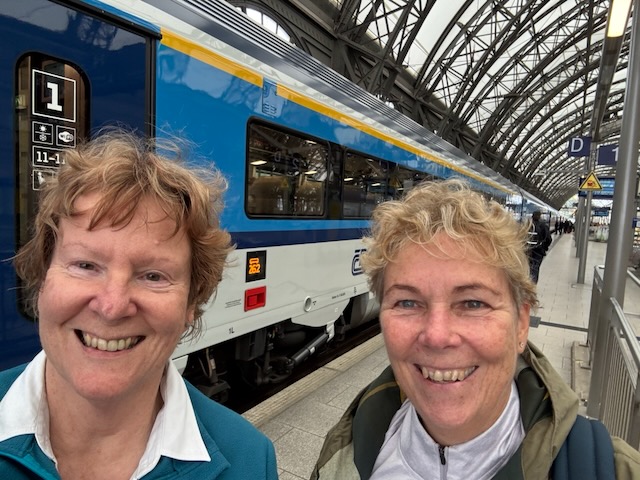
Anna and I arrive in Dresden
We’d booked at hotel in the middle of the Old Town in Schloßstraße (Castle Street) and indeed the castle was a few steps away.
About Dresden
Dresden is the capital city of the German state of Saxony and its second most populous city after Leipzig. It’s the twelfth most populous city of Germany and surprisingly, the fourth largest by area (only outstripped by Berlin, Hamburg and Cologne). After Berlin and Leipzig, it’s the third-most populous city in the former East Germany. And Dresden is the second largest city on the River Elbe after Hamburg. So it has a large imprint in today’s Germany.
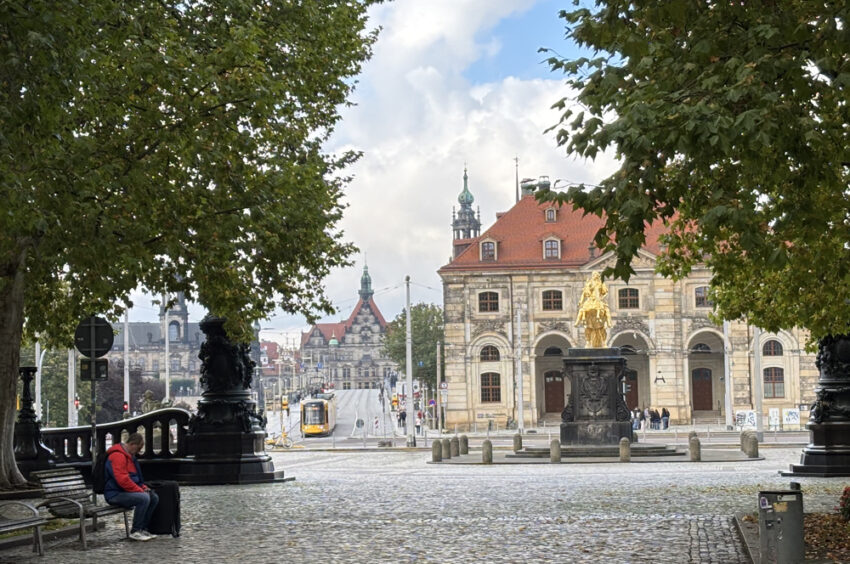
View across the Elbe from Neustadt. On the right, Jean-Joseph Vinache’s golden equestrian statue of August the Strong, the Goldener Reiter (Golden Cavalier)
Wealth, royal connections, war and reconstruction
Formerly the capital and royal residence for the Electors and Kings of Saxony, who for centuries furnished the city with cultural and artistic splendour, it was once (by personal union) the family seat of Polish monarchs. The city was known as the Jewel Box, because of its Baroque and Rococo city centre, let alone its wealth.
The Allied bombing of Dresden towards the end of the Second World War killed approximately 25,000 people, most of whom were civilians, and destroyed the entire city centre. After the war, restoration work, partly under the Communist regime and significantly since German reunification in 1990, has helped to reconstruct the historic inner city.
But our first stop – the Basteibrücke and Anna’s desire to see Saxon Switzerland!
The Bastei (bastion in English) itself is a sandstone rock formation rising 194 metres (636 ft) above the River Elbe – 305 metres (1,001 ft) above sea level. Once used as a mini fortress/lookout post, and mentioned as such in 1592, the Bastei has been a tourist attraction for the past two hundred years. In 1824, a wooden bridge was constructed to link several rocks for visitors. But wood… Hm. That bridge was replaced in 1851 by a splendid sandstone one and opened with a big celebration. The rock formations and vistas have inspired numerous artists, among them Caspar David Friedrich (and me!)

Photo: A.Savin – Own work (via Wikipedia) by Free Art Licence
Anna’s a keen walker and very fit, just like Mel. I’d researched the area, its transport links and footpaths for Double Stakes, so I knew the S-bahn train we had to take to the ferry point across the Elbe and where the route started. Of course, as the Bastei Bridge was nearly two hundred metres above the River Elbe, it was going to be uphill!

Ferry across the Elbe (Note the medieval castle above the other bank – very defensive!)
So up we went and the views down became ever more spectacular. Eventually, we reached the bridge. Once on the bridge itself, I fished out a copy of Double Stakes from my backpack and read the scene out loud. Most people ignored me, some may have given me odd looks, but I didn’t care. It was unlikely I would come back so I wanted to relish the moment.

We took a pause and had a delicious lunch in the Panorama Restaurant which certainly lived up to its name. Thirteen and a half kilometres later, up and down mountains, we stumbled back to our hotel.
Exploring Dresden Altstadt
Unsurprisingly, we had a slow-paced bumble round Dresden the next day. The castle (Residenzschloß) is one of the oldest buildings in Dresden. Known for the different architectural styles from Baroque to Neo-Renaissance, it was the residence of the electors and kings of Saxony and of Kings of Poland (for a period) for almost four hundred years.
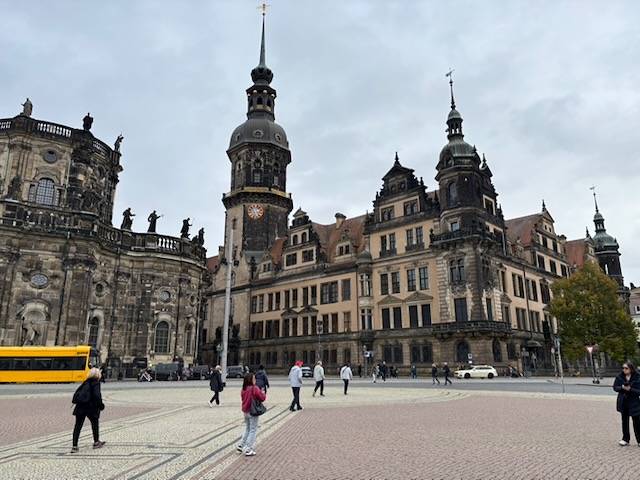
Dresden Castle
Most of the castle was reduced to a roofless shell during the February 1945 bombing of Dresden. However, the collections survived, having been moved to safety at nearby Königstein Fortress in the early years of the war. No attempt was made to rebuild the castle during the DDR time beyond installing a temporary roof in 1946. Some restoration began in the 1960s with the installation of some new windows, and progressed slowly in following decades, but took a considerable leap after re-unification in 1990.
We were not permitted to take photos in some rooms, especially some of the royal jewellery which was sumptuous, brilliant and a little overwhelming. But here are a few impressions of some other exhibits…
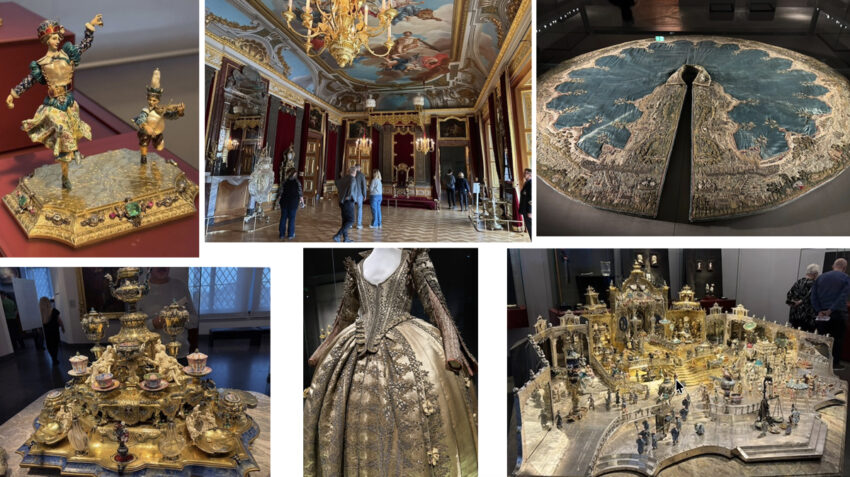
Dresden Castle treasures. Top row left to right: Meissen, gold and jewelled dancer and player; throne room; Elector Johann Georg I’s spectacular “landscape cloak”, 1611. Bottom row left to right: spectacular tea set; Electress Magdalena Sybille’s court gown; a panoramic scene in gold, silver, enamel and precious stones.
Outside, we found the Parade of Princes wall frieze in Meissen mosaics dating from 1906 celebrating rulers from the late medieval to before the First World War. A strong sense of German patriotic feeling was prevalent at the time it was made.

We strolled along Brühl’s Terrace, a stately promenade above the river, ate cake and generally walked round and admired the historical centre. So much has been restored, tastefully building on the remains, but signs of the 1945 bombing are visible everywhere as burnt soot and stain marks. Ongoing restoration work costing hundreds of millions of euros is everywhere in an effort to restore the impressive historic landscape of Dresden. But it’s not all history as the lively shopping areas demonstrate. International and German brands fill the modern shopping streets, especially between the main railways station and the Old Town.
On our last day, we ventured across the river to the Neustadt (New Town). Not new in the sense of built now, but mostly dating from the 18th and 19th centuries – it was new then!
Since 1989, Neustadt is said to be associated with counter-culture and anti-authoritarianism, typified by a high level of street art and graffiti. But it has the most concentrated collection of baroque architecture in Dresden, with winding alleys, passages, inner courtyards and wide boulevards lined by baroque facades.
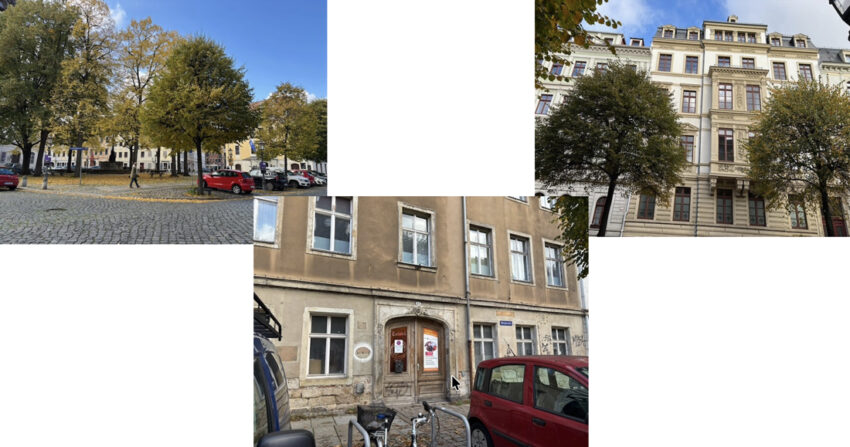
Dresden Neustadt: Gracious buildings, but one a little scruffier, non gentrified block with an original door
Then back down to the River Elbe for a walk with dramatic views over to the historic old town.
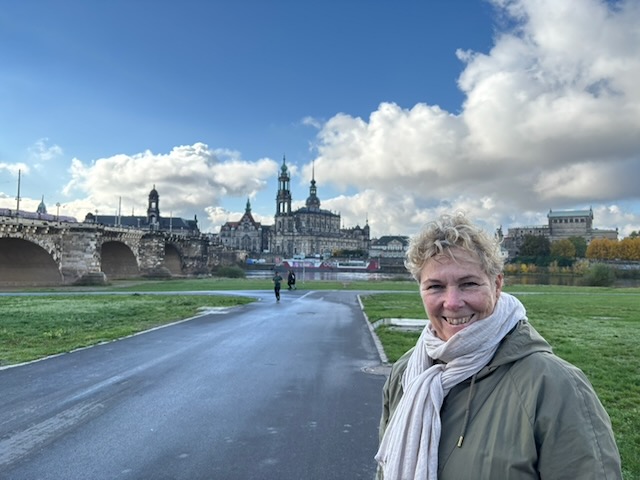
Anna, the Augustusbrücke and Dresden Old Town
Next we went to the Frauenkirche (Church of Our Lady), the famous, compact Lutheran church in the centre of the Altstadt. Built originally in the eighteenth century, restoration from the 1945 bombing only started in 1994 and lasted until 2005. The few parts still standing in the early nineties and stone from the surrounding rubble were integrated into the reconstruction. The Baroque style interior, mirroring the original, is stunning. The glazed gallery is the setting for a covert meeting between Mel and Federal Police detective Defne Yılmaz in Double Stakes.
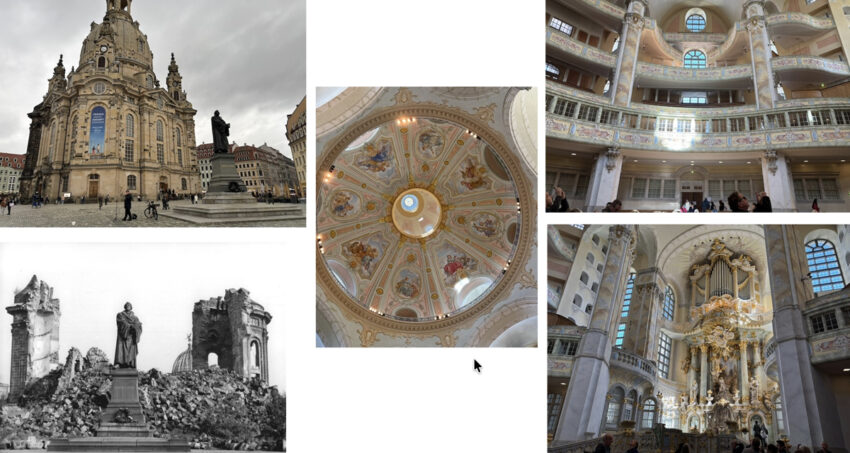
Frauenkirche. Left: above, exterior with Martin Luther statue in 2025, below, in 1958 still left as a ruin. Centre, the gilded ceiling. Right, above, the glazed gallery, below, the organ. All author photos except bottom left (Bundesarchiv, Bild 183-60015-0002 / Giso Löwe / CC-BY-SA 3.0)
Back across the Elbe, we needed refreshment, so cake was the obvious answer!

Local Eierschecke cake and hot chocolate
After a last look round, we made our way back to the hotel for a relaxing drink and preparing for a 7.30 am departure the next morning from this impressive and rather wonderful city.

Alison Morton is the author of Roma Nova thrillers – INCEPTIO, CARINA (novella), PERFIDITAS, SUCCESSIO, AURELIA, NEXUS (novella), INSURRECTIO and RETALIO, and ROMA NOVA EXTRA, a collection of short stories. Audiobooks are available for four of the series. Double Identity, a contemporary conspiracy, starts a new series of thrillers. JULIA PRIMA, Roma Nova story set in the late 4th century, starts the Foundation stories. The sequel, EXSILIUM, is now out.
Download ‘Welcome to Alison Morton’s Thriller Worlds’, a FREE eBook, as a thank you gift when you sign up to Alison’s monthly email update. As a result, you’ll be among the first to know about news and book progress before everybody else, and take part in giveaways.











I think we made a very good travelling team. How about next time we go to Merida in Spain?
Now there’s a thought! Lots of lovely Roman stuff! 😉